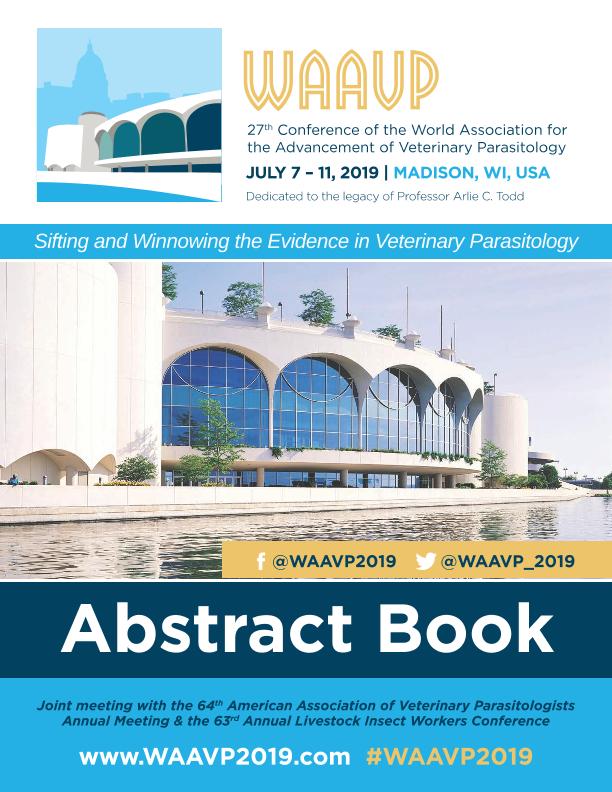Mostrar el registro sencillo del ítem
dc.contributor.author
Zegbi, Sara

dc.contributor.author
Sagüés, María Federica

dc.contributor.author
Saumell, Carlos Alfredo

dc.contributor.author
Iglesias, Lucía Emilia

dc.contributor.author
Guerrero, Ines

dc.contributor.author
Fernández, Alicia Silvina

dc.date.available
2022-06-29T11:44:40Z
dc.date.issued
2019
dc.identifier.citation
Efficacy of different concentrations of duddingtonia flagrans chlamydospores against different levels of faecal egg counts of cattle gastrointestinal nematodes; 27th Conference of the World Association for the Advancement of Veterinary Parasitology; Madison; Estados Unidos; 2019; 257-257
dc.identifier.uri
http://hdl.handle.net/11336/160726
dc.description.abstract
The nematophagous fungus Duddingtonia flagrans is a biocontrol agent that reduces the number of infective larvae of gastrointestinal nematodes in animal faeces, thus, lowering pasture infectivity. However, the minimum amount of fungal chlamydospores in faeces required for this effect is largely unknown. The following in vitro study aimed to determine the fungal efficacy of four different chlamydospores concentrations against three different levels of cattle faecal eggcounts. The chlamydospores concentrations tested were 11000, 6250, 3000 and 1000chl/g faeces. Faeces from naturally-infected calves were used to obtain faecal egg counts of 100, 480 and 840 epg. Ten faecal cultures of 10 g faeces each were set up for each chlamydospores concentration/faecal egg count combination, plus one control group for each faecal egg count level without chlamydospores. All cultures were kept at room temperature (20-26ºC) for two weeks and then L3 were recovered from each individual culture by overnight baermannisation, counted and identified. Thelarval reductions by D. flagrans, in decreasing order of chlamydospores concentrations, were: 100% (P<0.0001), 99% (P<0.0001),92% (P=0.0032) and 77% (ns) comparedto the 100 epg control; 100% (P<0.0001),98% (P<0.0001), 98% (P=0.0002) and 92%(ns) compared to the 480 epg control; and100% (P<0.0001), 100% (P<0.0001), 99%(P<0.0001) and 96% (ns) compared to the840 epg control. There were no differences between the three levels of faecal egg counts at any given fungal concentration, which indicates that the numbers of nematode eggsin cattle faeces would not be a determining factor for the efficacy of D. flagrans. These results suggest that the concentration of 1000 chl/g faeces would not be sufficient to achieve a significant fungal efficacy; however,it could be argued that, in practice, larval reductions of 77% to 96% would contribute tocontrol gastrointestinal nematodes.
dc.format
application/pdf
dc.language.iso
eng
dc.publisher
World Association for the Advancement of Veterinary Parasitology (WAAVP)
dc.rights
info:eu-repo/semantics/openAccess
dc.rights.uri
https://creativecommons.org/licenses/by-nc-sa/2.5/ar/
dc.subject
BIOLOGICAL CONTROL
dc.subject
DUDDINGTONIA FLAGRANS
dc.subject
GASTROINTESTINAL NEMATODES
dc.subject
CATTLE
dc.subject.classification
Ciencias Veterinarias

dc.subject.classification
Ciencias Veterinarias

dc.subject.classification
CIENCIAS AGRÍCOLAS

dc.subject.classification
Micología

dc.subject.classification
Ciencias Biológicas

dc.subject.classification
CIENCIAS NATURALES Y EXACTAS

dc.title
Efficacy of different concentrations of duddingtonia flagrans chlamydospores against different levels of faecal egg counts of cattle gastrointestinal nematodes
dc.type
info:eu-repo/semantics/publishedVersion
dc.type
info:eu-repo/semantics/conferenceObject
dc.type
info:ar-repo/semantics/documento de conferencia
dc.date.updated
2022-06-08T13:35:50Z
dc.journal.pagination
257-257
dc.journal.pais
Estados Unidos

dc.journal.ciudad
Madison
dc.description.fil
Fil: Zegbi, Sara. Consejo Nacional de Investigaciones Científicas y Técnicas. Centro Científico Tecnológico Conicet - Tandil. Centro de Investigación Veterinaria de Tandil. Universidad Nacional del Centro de la Provincia de Buenos Aires. Centro de Investigación Veterinaria de Tandil. Provincia de Buenos Aires. Gobernación. Comision de Investigaciones Científicas. Centro de Investigación Veterinaria de Tandil; Argentina
dc.description.fil
Fil: Sagüés, María Federica. Consejo Nacional de Investigaciones Científicas y Técnicas. Centro Científico Tecnológico Conicet - Tandil. Centro de Investigación Veterinaria de Tandil. Universidad Nacional del Centro de la Provincia de Buenos Aires. Centro de Investigación Veterinaria de Tandil. Provincia de Buenos Aires. Gobernación. Comision de Investigaciones Científicas. Centro de Investigación Veterinaria de Tandil; Argentina
dc.description.fil
Fil: Saumell, Carlos Alfredo. Consejo Nacional de Investigaciones Científicas y Técnicas. Centro Científico Tecnológico Conicet - Tandil. Centro de Investigación Veterinaria de Tandil. Universidad Nacional del Centro de la Provincia de Buenos Aires. Centro de Investigación Veterinaria de Tandil. Provincia de Buenos Aires. Gobernación. Comision de Investigaciones Científicas. Centro de Investigación Veterinaria de Tandil; Argentina
dc.description.fil
Fil: Iglesias, Lucía Emilia. Consejo Nacional de Investigaciones Científicas y Técnicas. Centro Científico Tecnológico Conicet - Tandil. Centro de Investigación Veterinaria de Tandil. Universidad Nacional del Centro de la Provincia de Buenos Aires. Centro de Investigación Veterinaria de Tandil. Provincia de Buenos Aires. Gobernación. Comision de Investigaciones Científicas. Centro de Investigación Veterinaria de Tandil; Argentina
dc.description.fil
Fil: Guerrero, Ines. Consejo Nacional de Investigaciones Científicas y Técnicas. Centro Científico Tecnológico Conicet - Tandil. Centro de Investigación Veterinaria de Tandil. Universidad Nacional del Centro de la Provincia de Buenos Aires. Centro de Investigación Veterinaria de Tandil. Provincia de Buenos Aires. Gobernación. Comision de Investigaciones Científicas. Centro de Investigación Veterinaria de Tandil; Argentina
dc.description.fil
Fil: Fernández, Alicia Silvina. Consejo Nacional de Investigaciones Científicas y Técnicas. Centro Científico Tecnológico Conicet - Tandil. Centro de Investigación Veterinaria de Tandil. Universidad Nacional del Centro de la Provincia de Buenos Aires. Centro de Investigación Veterinaria de Tandil. Provincia de Buenos Aires. Gobernación. Comision de Investigaciones Científicas. Centro de Investigación Veterinaria de Tandil; Argentina
dc.relation.alternativeid
info:eu-repo/semantics/altIdentifier/url/http://www.waavp2019.com
dc.relation.alternativeid
info:eu-repo/semantics/altIdentifier/url/http://www.waavp2019.com/wp-content/uploads/2019/07/WAAVP2019-Abstract-Book.pdf
dc.conicet.rol
Autor

dc.conicet.rol
Autor

dc.conicet.rol
Autor

dc.conicet.rol
Autor

dc.conicet.rol
Autor

dc.conicet.rol
Autor

dc.coverage
Nacional
dc.type.subtype
Conferencia
dc.description.nombreEvento
27th Conference of the World Association for the Advancement of Veterinary Parasitology
dc.date.evento
2019-07-07
dc.description.ciudadEvento
Madison
dc.description.paisEvento
Estados Unidos

dc.type.publicacion
Book
dc.description.institucionOrganizadora
World Association for the Advancement of Veterinary Parasitology
dc.source.libro
Abstract Book: 27th Conference of the World Association for the Advancement of Veterinary Parasitology
dc.date.eventoHasta
2019-07-11
dc.type
Conferencia
Archivos asociados
